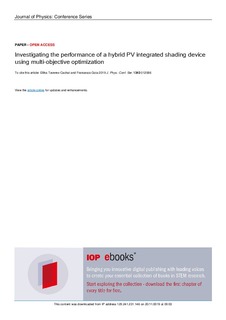| dc.contributor.author | Taveres-Cachat, Ellika | |
| dc.contributor.author | Goia, Francesco | |
| dc.date.accessioned | 2019-11-20T17:14:50Z | |
| dc.date.available | 2019-11-20T17:14:50Z | |
| dc.date.created | 2019-09-13T10:59:56Z | |
| dc.date.issued | 2019 | |
| dc.identifier.issn | 1742-6588 | |
| dc.identifier.uri | http://hdl.handle.net/11250/2629599 | |
| dc.description.abstract | PV integrated shading devices (PVSDs) are an interesting case study for an optimisation problem as their design is non-trivial and they must balance competing parameters and uses of solar energy. In this study, the case of a south-facing, exterior louvre blade PVSD was used to investigate how multi-objective optimisation (MOO) coupled to a parametric design approach can be used as a support tool to improve the performance of the system in four different cases. The parameters optimized were the individual tilt angle of each louvre-blade (0, 15, 30 or 45 ° from the horizontal), the vertical distribution of the blades, and the type of material on the upper surface of each louvre (reflective coating or PV cells). The objectives of the optimisation were to minimise the total annual net energy electricity use and to maximise the daylighting level in the zone. The results of the investigation showed that PVSD configurations with higher louvre counts performed better as hybrid systems as they allowed to increase daylighting compared to classic, fully PV coated systems and did not increase energy use in the zone significantly. However, for systems with lower counts of louvres, the results of the optimisation showed that the surface of the louvres was more useful as a PV element, as reflective materials had little effect on the daylighting in the zone and the reduction in energy converted noticeably affected the energy performance of the building. | |
| dc.language.iso | eng | |
| dc.publisher | IOP Publishing Ltd. | |
| dc.relation.ispartof | CISBAT 2019 | |
| dc.rights | CC BY 3.0 | |
| dc.rights.uri | https://creativecommons.org/licenses/by/3.0/ | |
| dc.title | Investigating the performance of a hybrid PV integrated shading device using multi-objective optimization | |
| dc.type | Conference object | |
| dc.type | Journal article | |
| dc.type | Peer reviewed | |
| dc.description.version | publishedVersion | |
| dc.rights.holder | © 2019 The authors | |
| dc.subject.nsi | VDP::Konstruksjonsteknologi: 533 | |
| dc.subject.nsi | VDP::Construction technology: 533 | |
| dc.source.volume | 1343 | |
| dc.source.journal | Journal of Physics: Conference Series | |
| dc.identifier.doi | 10.1088/1742-6596/1343/1/012086 | |
| dc.identifier.cristin | 1724409 | |
| dc.relation.project | Norges forskningsråd: 255252/E20 | |
| cristin.unitcode | 7401,30,40,0 | |
| cristin.unitname | Arkitektur, byggematerialer og konstruksjoner | |
| cristin.ispublished | true | |
| cristin.fulltext | original | |
| cristin.qualitycode | 1 | |

